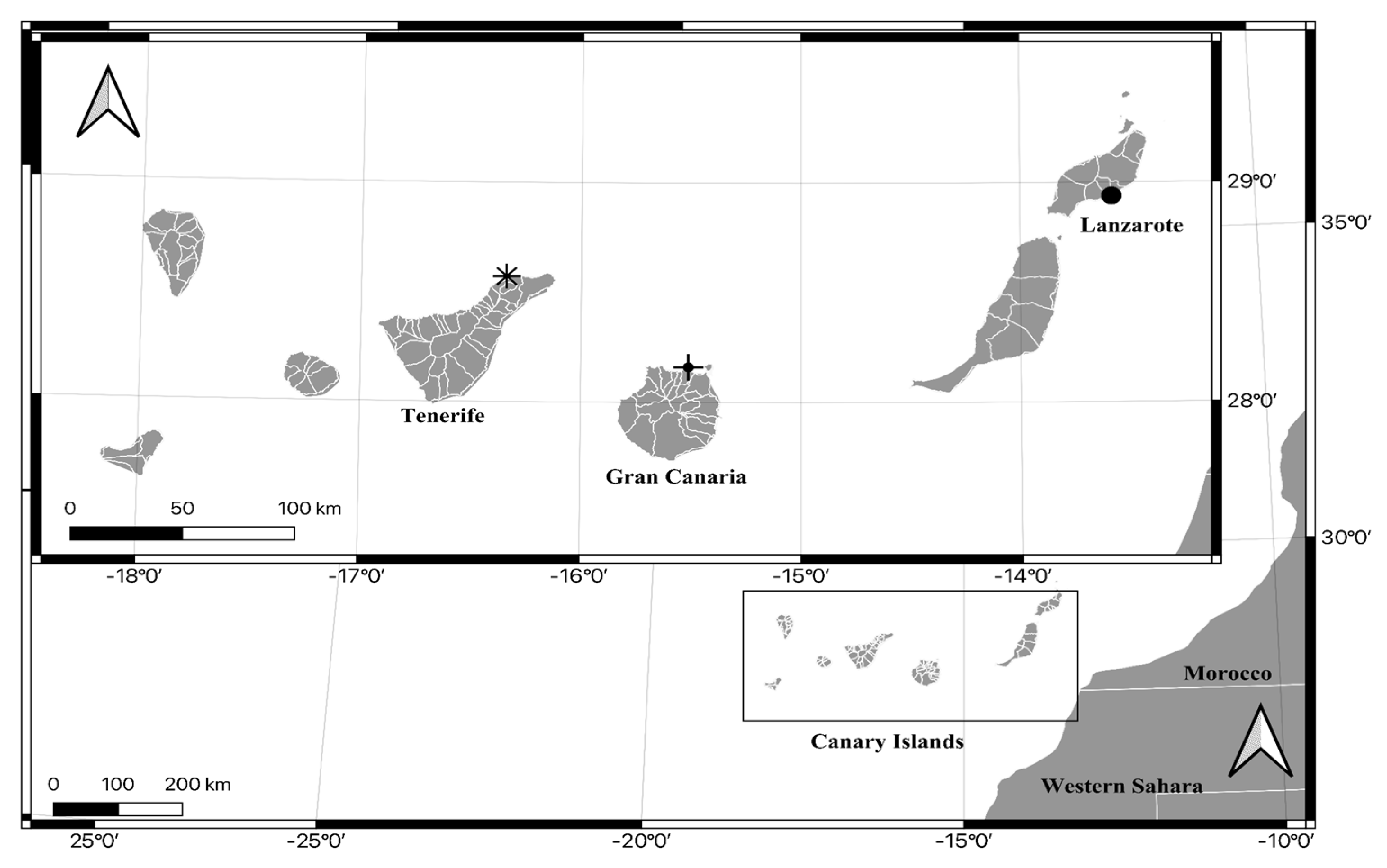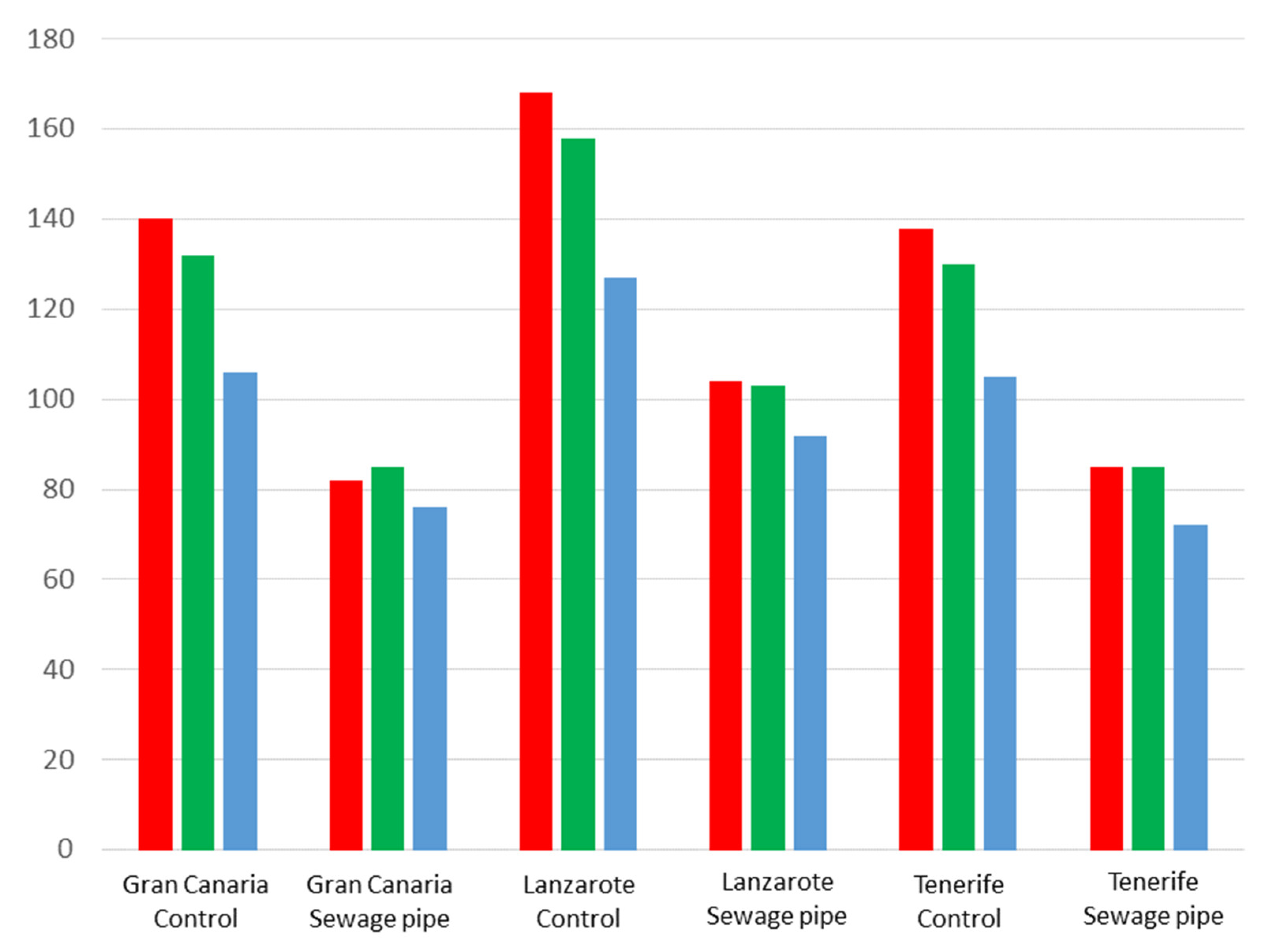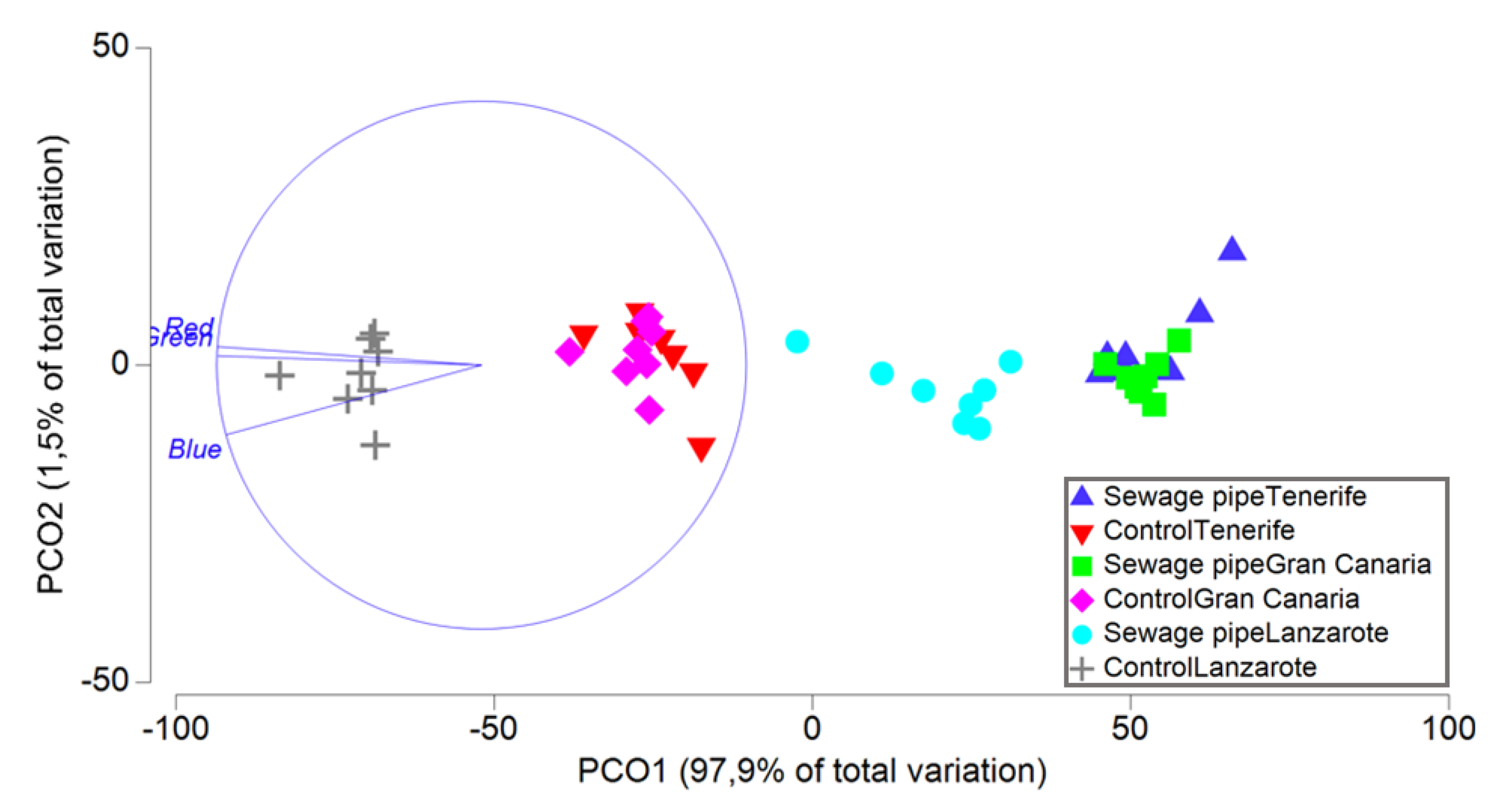Sewage Pipe Waters Affect Colour Composition in Palaemon Shrimp from the Intertidal in the Canary Islands: A New Non-lethal Bioindicator of Anthropogenic Pollution
Abstract
1. Introduction
2. Materials and Methods
Statistical Analyses
3. Results
4. Discussion and Conclusions
Author Contributions
Funding
Institutional Review Board Statement
Data Availability Statement
Conflicts of Interest
References
- Genthe, B.; Kapwata, T.; Le Roux, W.; Chamier, J.; Wright, C.Y. The reach of human health risks associated with metals/metalloids in water and vegetables along a contaminated river catchment: South Africa and Mozambique. Chemosphere 2018, 199, 1–9. Available online: http://www.sciencedirect.com/science/article/pii/S0045653518301772 (accessed on 15 February 2023). [CrossRef] [PubMed]
- Abdel Ghani, S.A. Trace metals in seawater, sediments and some fish species from Marsa Matrouh Beaches in north-western Mediterranean coast, Egypt. Egypt. J. Aquat. Res. 2015, 41, 145–154. Available online: http://www.sciencedirect.com/science/article/pii/S1687428515000199 (accessed on 23 January 2023). [CrossRef]
- Irabien, M.J.; Velasco, F. Heavy metals in Oka river sediments (Urdaibai National Biosphere Reserve, northern Spain): Lithogenic and anthropogenic effects. Environ. Geol. 1999, 37, 54–63. [Google Scholar] [CrossRef]
- Goutte, A.; Barbraud, C.; Herzke, D.; Bustamante, P.; Angelier, F.; Tartu, S.; Clément-Chastel, C.; Moe, B.; Bech, C.; Gabrielsen, G.W.; et al. Survival rate and breeding outputs in a high Arctic seabird exposed to legacy persistent organic pollutants and mercury. Environ. Pollut. 2015, 200, 1–9. [Google Scholar] [CrossRef]
- Lozano-Bilbao, E.; Alcázar-Treviño, J.; Fernández, J.J. Determination of δ15N in Anemonia sulcata as a pollution bioindicator. Ecol. Indic. 2018, 90, 179–183. [Google Scholar] [CrossRef]
- Ruilian, Y.; Xing, Y.; Zhao, Y.; Hu, G.; Tu, X. Heavy metal pollution in intertidal sediments from Quanzhou Bay, China. J. Environ. Sci. 2008, 20, 664–669. [Google Scholar]
- Laurent, O.; Bard, D.; Filleul, L.; Segala, C. Effect of socioeconomic status on the relationship between atmospheric pollution and mortality. J. Epidemiol. Community Health 2007, 61, 665–675. [Google Scholar] [CrossRef]
- Handoh, I.C.; Kawai, T. Modelling exposure of oceanic higher trophic-level consumers to polychlorinated biphenyls: Pollution ‘hotspots’ in relation to mass mortality events of marine mammals. Mar. Pollut. Bull. 2014, 85, 824–830. [Google Scholar] [CrossRef]
- Ferretti, F.; Worm, B.; Britten, G.L.; Heithaus, M.R.; Lotze, H.K. Patterns and ecosystem consequences of shark declines in the ocean. Ecol. Lett. 2010, 13, 1055–1071. [Google Scholar] [CrossRef]
- Hipfner, J.M.; Galbraith, M.; Tucker, S.; Studholme, K.R.; Domalik, A.D.; Pearson, S.F.; Good, T.P.; Ross, P.S.; Hodum, P. Two forage fishes as potential conduits for the vertical transfer of microfibres in Northeastern Pacific Ocean food webs. Environ. Pollut. 2018, 239, 215–222. Available online: http://www.sciencedirect.com/science/article/pii/S0269749117351047 (accessed on 8 February 2023). [CrossRef]
- Lozano-Bilbao, E.; Lozano, G.; Gutiérrez, J.; Hardisson, A.; Rubio, C.; Paz, S.; Weller, D.G. The influence of the degassing phase of the Tagoro submarine volcano (Canary Islands) on the metal content of three species of cephalopods. Mar. Pollut. Bull. 2022, 182, 113964. Available online: https://www.sciencedirect.com/science/article/pii/S0025326X22006464 (accessed on 10 February 2023). [CrossRef] [PubMed]
- Bendell, L.I.; LeCadre, E.; Zhou, W. Use of sediment dwelling bivalves to biomonitor plastic particle pollution in intertidal regions; A review and study. PLoS ONE 2020, 15, e0232879. [Google Scholar] [CrossRef] [PubMed]
- Hwang, D.W.; Kim, P.J.; Kim, S.G.; Sun, C.I.; Koh, B.S.; Ryu, S.O.; Kim, T.H. Spatial distribution and pollution assessment of metals in intertidal sediments, Korea. Environ. Sci. Pollut. Res. 2019, 26, 19379–19388. [Google Scholar] [CrossRef]
- Frédou, F.L.; Frédou, T.; Gaertner, D.; Kell, L.; Potier, M.; Bach, P.; Travassos, P.; Hazin, F.; Ménard, F. Life history traits and fishery patterns of teleosts caught by the tuna longline fishery in the South Atlantic and Indian Oceans. Fish. Res. 2016, 179, 308–321. [Google Scholar] [CrossRef]
- Lozano-Bilbao, E.; Lozano, G.; Jiménez, S.; Jurado-Ruzafa, A.; Hardisson, A.; Rubio, C.; Weller, D.-G.; Paz, S.; Gutiérrez, J. Seasonal and ontogenic variations of metal content in the European pilchard (Sardina pilchardus) in northwestern African waters. Environ. Pollut. 2020, 266, 115113. Available online: http://www.sciencedirect.com/science/article/pii/S0269749120329407 (accessed on 10 February 2023). [CrossRef]
- Karunasagar, D.; Krishna, M.V.B.; Anjaneyulu, Y.; Arunachalam, J. Studies of mercury pollution in a lake due to a thermometer factory situated in a tourist resort: Kodaikkanal, India. Environ. Pollut. 2006, 143, 153–158. [Google Scholar] [CrossRef]
- Aydin-Önen, S.; Öztürk, M. Investigation of heavy metal pollution in eastern Aegean Sea coastal waters by using Cystoseira barbata, Patella caerulea, and Liza aurata as biological indicators. Environ. Sci. Pollut. Res. 2017, 24, 7310–7334. [Google Scholar] [CrossRef]
- Wang, X.; Zhang, C.; Zhang, Z. Pollution haven or porter? The impact of environmental regulation on location choices of pollution-intensive firms in China. J. Environ. Manag. 2019, 248, 109248. [Google Scholar] [CrossRef]
- Anand, K.S.; Giraud-Carrier, F.C. Pollution regulation of competitive markets. Manag. Sci. 2020, 66, 4193–4206. [Google Scholar] [CrossRef]
- Neves, S.A.; Marques, A.C.; Patrício, M. Determinants of CO2 emissions in European Union countries: Does environmental regulation reduce environmental pollution? Econ. Anal. Policy 2020, 68, 114–125. [Google Scholar] [CrossRef]
- Lionetto, M.G.; Caricato, R.; Giordano, M.E.; Pascariello, M.F.; Marinosci, L.; Schettino, T. Integrated use of biomarkers (acetylcholinesterase and antioxidant enzymes activities) in Mytilus galloprovincialis and Mullus barbatus in an Italian coastal marine area. Mar. Pollut. Bull. 2003, 46, 324–330. [Google Scholar] [CrossRef]
- Ding, J.; Sun, C.; He, C.; Li, J.; Ju, P.; Li, F. Microplastics in four bivalve species and basis for using bivalves as bioindicators of microplastic pollution. Sci. Total. Environ. 2021, 782, 146830. [Google Scholar] [CrossRef]
- Manickavasagam, S.; Sudhan, C.; Aanand, S. Bioindicators in aquatic environment and their significance. J. Aquac. Trop. 2019, 34, 73–79. [Google Scholar] [CrossRef]
- Thorne-Bazarra, T.; Lozano-Bilbao, E.; Triay-Portella, R.; Hardisson, A.; Paz, S.; Rubio-Armendariz, C.; Martín, V.; Gutiérrez, A.J. Metallic Study of the Invasive Species Cronius ruber—Assessment of Toxic Risk. Appl. Sci. 2022, 12, 3217. [Google Scholar] [CrossRef]
- Chandurvelan, R.; Marsden, I.D.; Glover, C.N.; Gaw, S. Assessment of a mussel as a metal bioindicator of coastal contamination: Relationships between metal bioaccumulation and multiple biomarker responses. Sci. Total. Environ. 2015, 511, 663–675. [Google Scholar] [CrossRef]
- Tokatli, C. Comparisons of diatoms and fishes as toxic metal bioindicator: A case study of an A-class wetland in northwest Turkey under effect of an intensive paddy cultivation stress. Environ. Sci. Pollut. Res. 2022, 29, 87231–87244. [Google Scholar] [CrossRef]
- McCauley, D.J.; Pinsky, M.L.; Palumbi, S.R.; Estes, J.A.; Joyce, F.H.; Warner, R.R. Marine defaunation: Animal loss in the global ocean. Science 2015, 347, 1255641. [Google Scholar] [CrossRef]
- Lozano-Bilbao, E.; Espinosa, J.M.; Lozano, G.; Hardisson, A.; Rubio, C.; González-Weller, D.; Gutiérrez, A.J. Determination of metals in Anemonia sulcata (Pennant, 1777) as a pollution bioindicator. Environ. Sci. Pollut. Res. 2020, 27, 21621–21627. [Google Scholar] [CrossRef]
- Lozano-Bilbao, E.; Herranz, I.; González-Lorenzo, G.; Lozano, G.; Hardisson, A.; Rubio, C.; González-Weller, D.; Paz, S.; Gutiérrez, A.J. Limpets as bioindicators of element pollution in the coasts of Tenerife (Canary Islands). Environ. Sci. Pollut. Res. 2021, 28, 42999–43006. [Google Scholar] [CrossRef]
- Lozano-Bilbao, E.; González-Delgado, S.; Alcázar-Treviño, J. Use of survival rates of the barnacle Chthamalus stellatus as a bioindicator of pollution. Environ. Sci. Pollut. Res. 2021, 28, 1247–1253. [Google Scholar] [CrossRef]
- Amat, J.A.; Rendón, M.A. Flamingo coloration and its significance. In Flamingos, Behavior, Biology, and Relationship with Humans; Nova Science Publishers, Inc.: New York, NY, USA, 2017; pp. 77–95. [Google Scholar]
- Woolf, M.S.; Dignan, L.M.; Scott, A.T.; Landers, J.P. Digital postprocessing and image segmentation for objective analysis of colorimetric reactions. Nat. Protoc. 2021, 16, 218–238. [Google Scholar] [CrossRef] [PubMed]
- Anderson, M.; Braak, C.T. Permutation tests for multi-factorial analysis of variance. J. Stat. Comput. Simul. 2003, 73, 85–113. [Google Scholar] [CrossRef]
- Anderson, M.R. The Resource for the Power Industry Professional. Proc. ASME Power 2004, 32. [Google Scholar]
- Herrera, E.T.; Lozano-Bilbao, E.; Lozano, G.; Hardisson, A.; Rubio, C.; González-Weller, D.; Gutiérrez, Á.J. Influencia metálica de un emisario submarino de Punta del Hidalgo, en el norte de Tenerife, Islas Canarias, España. Majorensis 2020, 16, 12–19. [Google Scholar]
- González-Delgado, S.; Lozano-Bilbao, E.; Alcázar-Treviño, J. Habitat preference of Anemonia sulcata in intertidal pools in the North-East Atlantic. Majorensis 2018, 14, 7–11. [Google Scholar]
- Canary Islands Institute of Statistics (ISTAC). Available online: https://datos.canarias.es/catalogos/estadisticas/ (accessed on 15 February 2023).
- López, E.P.; García, F.C. Agrotourism, sustainable tourism and ultraperipheral areas: The case of Canary Islands. PASOS Rev. Tur. Patrim. Cult. 2006, 4, 85–97. [Google Scholar]
- Bianchi, R.V. Tourism restructuring and the politics of sustainability: A critical view from the European periphery (The Canary Islands). J. Sustain. Tour. 2004, 12, 495–529. [Google Scholar] [CrossRef]
- Carrillo, J.; González, A.; Pérez, J.C.; Expósito, F.J.; Díaz, J.P. Projected impacts of climate change on tourism in the Canary Islands. Reg. Environ. Chang. 2022, 22, 61. [Google Scholar] [CrossRef]
- García-Romero, L.; Carreira-Galbán, T.; Rodríguez-Báez, J.Á.; Máyer-Suárez, P.; Hernández-Calvento, L.; Yánes-Luque, A. Mapping Environmental Impacts on Coastal Tourist Areas of Oceanic Islands (Gran Canaria, Canary Islands): A Current and Future Scenarios Assessment. Remote. Sens. 2023, 15, 1586. [Google Scholar] [CrossRef]
- Martín Martín, J.M.; Guaita Martínez, J.M.; Molina Moreno, V.; Sartal Rodríguez, A. An analysis of the tourist mobility in the island of Lanzarote: Car rental vs. more sustainable transportation alternatives. Sustainability 2019, 11, 739. [Google Scholar] [CrossRef]
- Silvertown, J. A new dawn for citizen science. Trends Ecol. Evol. 2009, 24, 467–471. [Google Scholar] [CrossRef]
- Vohland, K.; Land-Zandstra, A.; Ceccaroni, L.; Lemmens, R.; Perelló, J.; Ponti, M.; Samson, R.; Wagenknecht, K. The Science of Citizen Science; Springer Nature: Berlin, Germany, 2021; 520p. [Google Scholar]
- Hof, A.E.V.T.; Campagne, P.; Rigden, D.J.; Yung, C.J.; Lingley, J.; Quail, M.A.; Saccheri, I.J. The industrial melanism mutation in British peppered moths is a transposable element. Nature 2016, 534, 102–105. [Google Scholar] [CrossRef]




| Colour | Control Zone | Sewage Pipe | |||||
|---|---|---|---|---|---|---|---|
| Gran Canaria | Lanzarote | Tenerife | Gran Canaria | Lanzarote | Tenerife | ||
| Red | Mean | 140 | 168 | 138 | 82 | 104 | 85 |
| SD | 3 | 4 | 7 | 2 | 7 | 3 | |
| Min | 134 | 161 | 127 | 81 | 97 | 80 | |
| Max | 147 | 176 | 149 | 87 | 115 | 88 | |
| Green | Mean | 132 | 158 | 130 | 85 | 103 | 85 |
| SD | 3 | 3 | 4 | 3 | 11 | 4 | |
| Min | 129 | 155 | 123 | 81 | 88 | 79 | |
| Max | 138 | 165 | 134 | 90 | 128 | 89 | |
| Blue | Mean | 106 | 127 | 105 | 76 | 92 | 72 |
| SD | 4 | 5 | 4 | 3 | 4 | 8 | |
| Min | 100 | 120 | 100 | 69 | 83 | 53 | |
| Max | 113 | 135 | 115 | 80 | 96 | 79 | |
| Gran Canaria | Lanzarote | Tenerife | |
|---|---|---|---|
| Sewage pipe vs. Control zone | 0.001 * F = 10.69 | 0.001 * F = 11.01 | 0.001 * F = 10.61 |
| Sewage Pipe | Control Zone | |
|---|---|---|
| Tenerife vs. Gran Canaria | 0.283 | 0.563 |
| Tenerife vs. Lanzarote | 0.003 * | 0.001 * |
| Gran Canaria vs. Lanzarote | 0.002 * | 0.002 * |
Disclaimer/Publisher’s Note: The statements, opinions and data contained in all publications are solely those of the individual author(s) and contributor(s) and not of MDPI and/or the editor(s). MDPI and/or the editor(s) disclaim responsibility for any injury to people or property resulting from any ideas, methods, instructions or products referred to in the content. |
© 2023 by the authors. Licensee MDPI, Basel, Switzerland. This article is an open access article distributed under the terms and conditions of the Creative Commons Attribution (CC BY) license (https://creativecommons.org/licenses/by/4.0/).
Share and Cite
Lozano-Bilbao, E.; Alcázar-Treviño, J. Sewage Pipe Waters Affect Colour Composition in Palaemon Shrimp from the Intertidal in the Canary Islands: A New Non-lethal Bioindicator of Anthropogenic Pollution. Diversity 2023, 15, 658. https://doi.org/10.3390/d15050658
Lozano-Bilbao E, Alcázar-Treviño J. Sewage Pipe Waters Affect Colour Composition in Palaemon Shrimp from the Intertidal in the Canary Islands: A New Non-lethal Bioindicator of Anthropogenic Pollution. Diversity. 2023; 15(5):658. https://doi.org/10.3390/d15050658
Chicago/Turabian StyleLozano-Bilbao, Enrique, and Jesús Alcázar-Treviño. 2023. "Sewage Pipe Waters Affect Colour Composition in Palaemon Shrimp from the Intertidal in the Canary Islands: A New Non-lethal Bioindicator of Anthropogenic Pollution" Diversity 15, no. 5: 658. https://doi.org/10.3390/d15050658
APA StyleLozano-Bilbao, E., & Alcázar-Treviño, J. (2023). Sewage Pipe Waters Affect Colour Composition in Palaemon Shrimp from the Intertidal in the Canary Islands: A New Non-lethal Bioindicator of Anthropogenic Pollution. Diversity, 15(5), 658. https://doi.org/10.3390/d15050658







